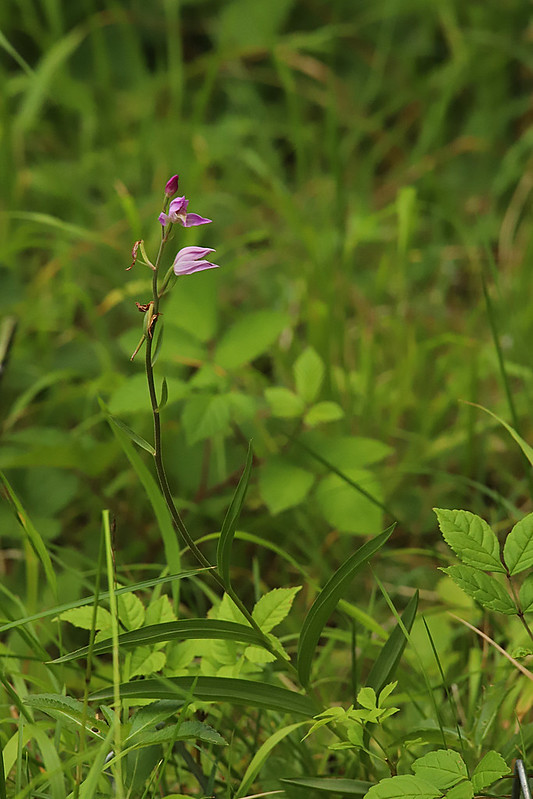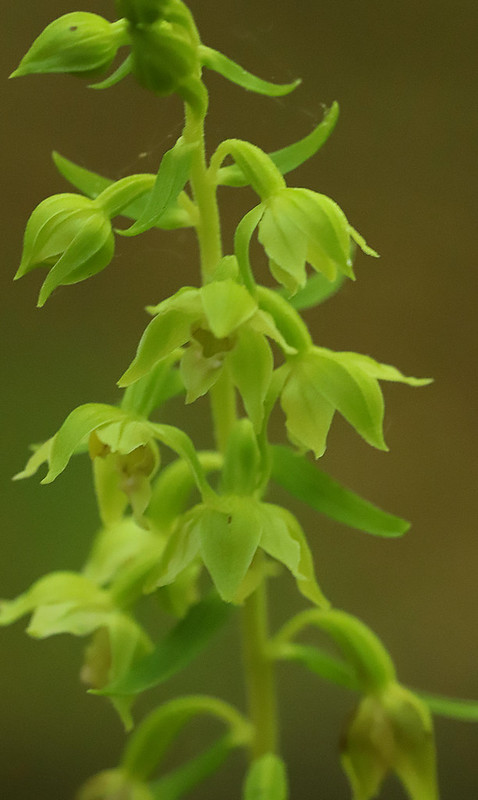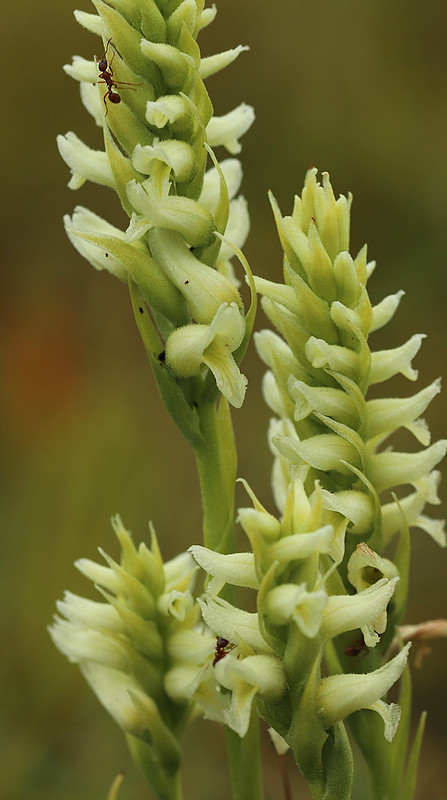Ireland and Norfolk.
May 2024.
West of Ireland. Pugslies and Dense Flowered.
A long day, with three site visits.
Ireland seems green. I mean it is green, 500 shades of green, doubly so when the sun shines, but a lot is given over to farming, so the parts showing the original nature are pretty much restricted to nooks and corners and reserves, which can mean having to travel miles between them to see a particular species.
So after a hearty Irish breakfast at eight, we assembled to load the cars at nine for the hour long drive to a small nature reserve about 70km north of Sligo.
We headed north through Ballyshannon and Donegal, the roads were good and traffic light. One feature is even two lane roads have a hard shoulder to the left of a dotted yellow line, for tractors mainly, it seems, but slow driver can, but usually don't, pull over.
There are regular filling stations, each with a place where you can get freshly made sandwiches or rolls. Like Subway but with real bread. It is true, that Subway cannot call their bread "bread" as it contains too much sugar.
So it goes.
After Donegal, we leave the main roads and head towards the coast. On the edge of an estuary, inland from some dunes, we stop and park.
The walk down the lane was rewarded with dozens of damselflies in the hedge, many defying identification for now anyways.
Over a stone style onto the reserve, and the first magenta coloured Early Marsh revealed itself.
On beside the brook we went, before the landscape opened out, and went out onto the flood plane, where there were many more Early Marsh, magenta and dark pink, so emerging Heath Spotted and several Lesser Butterflies just about to flower.
A huge tick was the arrival of a newly emerged Marsh Fritillary, who gave good long displays of under and overwings, so much so we all got shots.
Back to the car past the demselflies and butterflies of the hedge, then all back in the car drive further north to St John's Point, collecting sandwiches and wraps from a filling station on the way.
At the end of the public road, there is a white beach, with the headland stretching out behind. On this day, without a breath of wind, the sky was reflected perfectly on the still sea.
We sat at picnic benches to eat our packed lunch, while the twitches scoured the rocks for shags and divers.
This was our second site for the day: a peninsular stretching out into the east Atlantic, living in a bog nearly at the end, soaking their roots hidden from the track that passes nearby.

In the distance, a thunderstorm rumbled, and the sunny and warm morning had given way to a darker and gloomier afternoon with the promise of rain sooner rather than later.

We saw the orchid, though I bailed again on a trek to see more lower down in wetter conditions, so limped back to the car.
I sat and listened to podcasts while people watching as they came to the small beach. All the while, distant thunder echoed around the landscape, getting more distant.
Over an hour later, the others came back, so we drove over an hour away to a large dune system.
It had been a long day, we were tired, and more storms were building, the sunshine of the morning was a distant memory, and a cool wind had set in.

We walked in file up into the dunes, turning off after a while, looking for tiny spikes among the other vegetation.

After an hour, over a dozen were found, but all had done over to seed and were going brown, as the Dense Flowered Orchid only flowers for a few days.
But these counts.
I walked back to the car while the rest did some more exploring, and so at half seven we all climbed in, happy with the day, and dreaming of fish and chips from a nearby town. But the chippy closed at eight and was half an hour away, and sure enough when we arrived, it was closing.
We went to a nearby bar, who were very accommodating in seating eight without reservations and serving us promptly and for me, one of the best vegetable curries I have had.
The two pints of Guinness I fell were well earned.
After that, we went back outside, the rain had arrived, so we rushed back to the car, and had a 70 minute drive through the gathering gloom back to Sligo, not getting back until half ten.
Phew.
The next day.
It its not already obvious by now, the reason we were on Ireland was orchids. But in particular, for me to tick off three of the last four species of UK and Ireland I had yet to see.
Apart from these three species, there is one more, Creeping Lady's Tresses, yet to see, and that should be taken care of later in the year.
We shall see.
So having ticked off Pugsley's and Dense Flowered Orchids, the final target for this week was Irish Marsh Orchid. And for that we needed to head south.
Quite a way south.
Best strap ourselves in for the long drive.
Jools was going with another "plus one", on a trip to Tory Island to see and shake hands with their "king".
This meant a dinner dead on half seven, and on the road for them by eight.
I finished my lazy breakfast, and then went to the room to get ready.
So, we would have to drive south for nearly two hours, two hours through cloudy, misty weather with occasional drizzle turning to steady rain as we neared the sites.
As we followed a lorry, on either side, in the deep vegetation of the verge, we could see the vibrant purple spikes appearing of the Irish Marsh. We could have stopped but it would have been dangerous, and there was a much safer site a few miles further on.

In the grounds of a former factory, the once neat lawn now managed to return to nature had hundreds of purple spikes: singles, pairs and even a couple of triple groups. And the orchid Gods smiled, the clouds cleared and the sun shone on the scene.

Though the wind did begin to blow, very hard, making macro hard, but I seemed to cope.
After an hour, we were done, so we drove to the nearby Eurospar for supplies, then on to a wetland reserve to look for Red-necked Phalaropes at their only breeding site in the British Isles.

Cloud had returned, the wind redoubled, and it was downright chilly if not cold. We had our lunch, and the twitchers and birders went to try to see the two females in residence.
So, after an hour we drove to the final site of the tour, a low lying verge and picnic area beside an inland lough.
A mixture of mostly Irish Marsh, with some Early Marsh mixed in, hunkered down against the wind. We spent an hour or so photographing most spikes, looking for hybrids or at least interesting spikes.
And then for the two hour drive back, but first, on a tip off, we drove to a field where we could hear the rasping of at least on Corncrake, if not two. But despite sitting there for half an hour, not one showed itself.
But hearing the call is a privilege.
Back to Sligo then in drizzle, but we made good time, getting back just after six. Jools wasn't back from her trip to Tory Island, and the windy and rough conditions made the ferry late, she would be unable to join us for dinner as she would not get back until half nine.
And so to the last species, from last weekend. A Scottish species. In Norfolk, and another Fragrant.
The story of how a Scottish and northern English orchid species came to be found at the edge of a Norfolk beach shows how biodiversity can spread.
The landowners at nearby Holkham Hall had fir trees planted, and in the soil were orchid seeds.
Nature does the rest.
There are several small colonies around the woods, but this was/is the most accessible.
The reason for driving from Dover to Wells-Next-the-Sea and back was to complete the UK and Irish Orchid set, as it were. As apart from the legendary Ghost Orchid, by the end of Saturday I would have seen all other species.
It has taken some 14 years, twelve if you look outside of Kent, and involved two two-week holidays to Northumberland, and trips to the New Forest, the Welsh coast, Lancashire, Gloucestershire, Essex, Suffolk and this year, Ireland.
How many species, I hear you ask. Well, depends.
As the Lindisfarne Helleborine is no longer considered a separate species from Dune Helleborine, but was when I saw it. And does the Tongue Orchid or Giant Orchid now be considered UK species as they have naturalised?
I don't know.
Exactly.
We left Dover at half five, having to go up the M20, contraflow and heavy traffic, as the M2 was closed until half ten.
It was a glorious morning, lots of sunshine and little traffic, which was a pleasant surprise.
Over the Thames, or rather under it, then along to the M11 and up through Essex, into Cambridgeshire, Suffolk and finally Norfolk.
Traffic in Brandon was light, and sadly no planes seen moving at RAF Lakenheath, up through Breckland, Thetford Forest to Swaffham, Fakenham and Wells.
Queens Anne's Drive is a long car park owned by Holkham, and folks were arriving to go to the beach. We parked, then set off away from the soon to be busy beach, though light woodland, past a pond, then up and over some dune sacks via a boardwalk to the beach.
From here is was 3,300 steps, or so what3words told me, so we wet off west, along the path at the edge of the woods, until we came to a crossing where two paths met, and just the other side were six tiny plants.

This was it.
These were it.
Creeping Lady's Tresses.
Related to Autumn Lady's Tresses, clearly, but hairier, and much rarer.
I lay down to get shots, whilst Jools looked for other plants. None found, so as the temperature rose, we turned round to walk back to the car, the whole hike having taken just under two hours by the time we reached the car, and just about every parking space taken.

According to maps there is an A road that runs along the north Norfolk coast. This is a joke on all those visitors who think its a quick way of getting between Wells and Sheringham or Cromer. We have footpaths wider than this road in Kent.
I should point out that I am a son of Norfolk, and revel in that fact, and love it that the A149 that runs through places like Cley and Blakeney is barely wide enough for a single car, let alone two to pass, or the buses that come along every hour.
The 15 mile drive took best part of 45 minutes, arriving in Sheringham at the busiest time, with the market taking over half the car park beside the North Norfolk Railway.
No matter, we were not going here, our destination was a side road beside a housing estate, on the other side of the road was a nature reserve, Beeston & Sheringham Commons.
On here was my last species, the Marsh Fragrant.
Until a few years ago, all Fragrants were in the same family, then some DNA work was done, and the suspected differences meant that we had three fragrant species: the more common, er, Common (or Chalk), Heath and Marsh.
We have the Chalk in Kent. I had seen a single spike of Heath in Durham a decade back (still counts), so just the Marsh to see, and the Latin name means dense flowered, I though these would be easy to spot, large pink-lilac orchids of majestic height.
The site is large, and of different habitats, and even when on the notice board it confirmed the species here, no hint of where it might be found.
Marsh was the give away, and in the Central Mire we concentrated our search, and after an hour of huffing, puffing and stepping in muddy pools and bogs, I finally found two small spikes.
I had already found Marsh Helleborines, so pretty sure we were in the right place.

Ten yards away were two much larger spikes, worth the wet foot I got from the floating fen.
Job done.
Unlike in a video game, I didn't get an extra life or added powers, just the job done.
The phone lead us back to the car, I was just about done in. 15,000 steps, but no actual pain, just the effort in what was a very warm day.
 Inside I could see the head of a large moth, I knew already what it was, so helped it out and gave it to Jools so I could snap it on her hand before putting it onto the thistles to warm up and fly off.
Inside I could see the head of a large moth, I knew already what it was, so helped it out and gave it to Jools so I could snap it on her hand before putting it onto the thistles to warm up and fly off. Other nice looking moths too, so I snap those, including two new for the garden including Golden spot. Then pack up the trap, put it back in the shed before going back inside for more coffee and begin work.
Other nice looking moths too, so I snap those, including two new for the garden including Golden spot. Then pack up the trap, put it back in the shed before going back inside for more coffee and begin work. I am just about caught up again, so do some calling around for some outstanding actions. And speak to Rune as he's back and we can have a communal whinge.
I am just about caught up again, so do some calling around for some outstanding actions. And speak to Rune as he's back and we can have a communal whinge. Which is nice.
Which is nice. Which is nice.
Which is nice. So it goes. So it goes.
So it goes. So it goes.












































